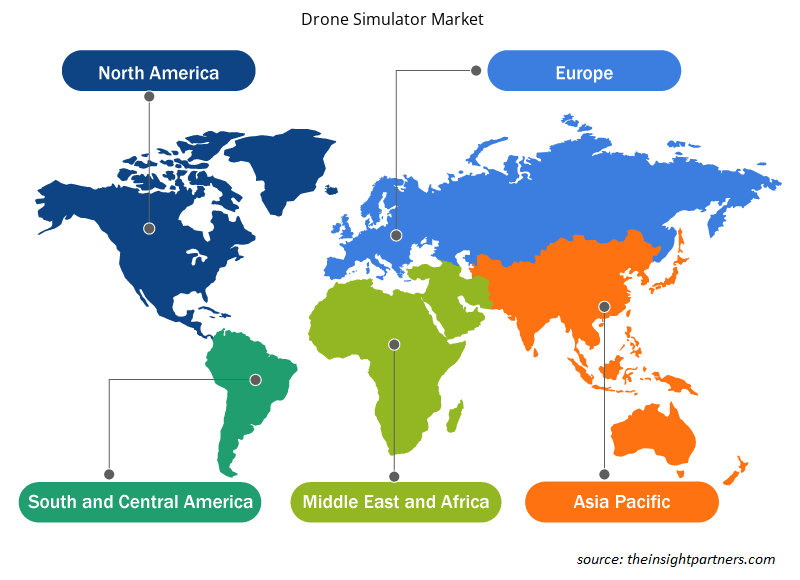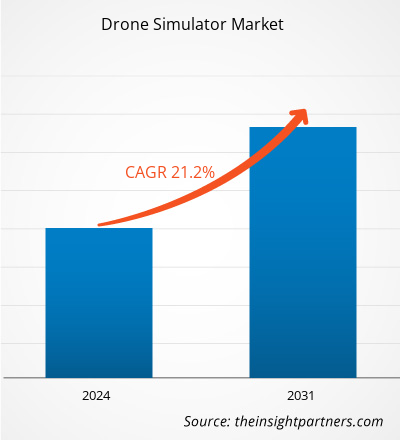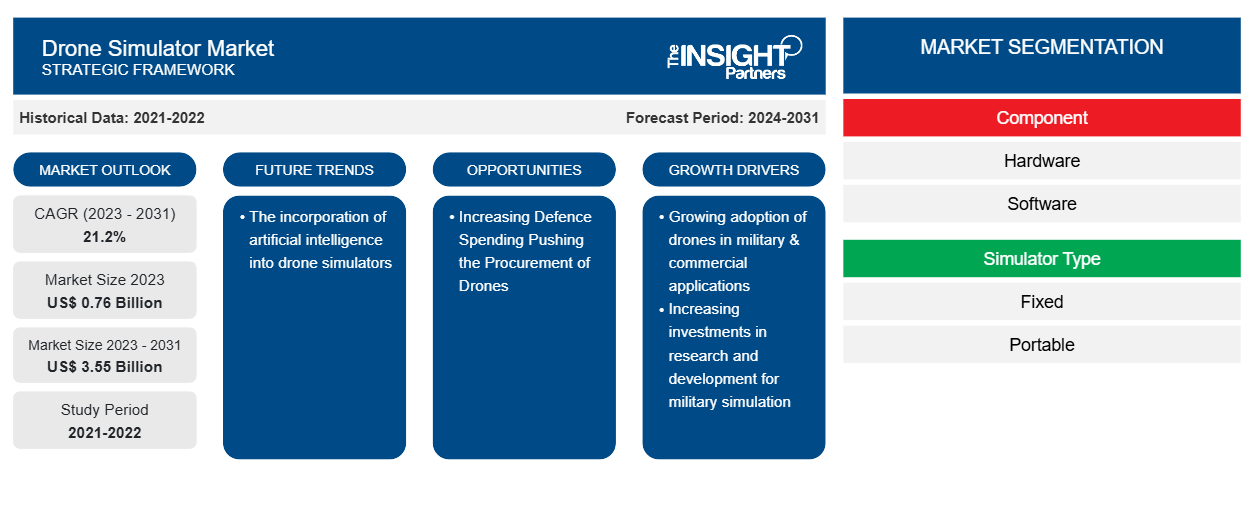Se prevé que el tamaño del mercado de simuladores de drones alcance los 3.550 millones de dólares en 2031, frente a los 760 millones de dólares en 2023. Se espera que el mercado registre una CAGR del 21,2 % durante el período 2023-2031. Es probable que la incorporación de inteligencia artificial siga siendo una tendencia clave en el mercado.
Análisis del mercado de simuladores de drones
El mercado de simuladores de drones está dominado principalmente por fabricantes líderes en la industria, como Aegis Technologies, Leonardo Spa, General Atomics e Israel Aerospace Industries, entre otros. La demanda de estos conectores entre los fabricantes de vehículos aéreos no tripulados es máxima. La presencia y la sólida imagen de marca de fabricantes reconocidos en la industria limitan la aparición de nuevos actores en el mercado. Además, la fabricación de simuladores de drones requiere el cumplimiento de varias normas establecidas por las respectivas autoridades gubernamentales y la adquisición de licencias para fabricar dichos productos es un proceso que requiere mucho capital. Este enorme requisito de capital es otro factor que restringe la entrada de actores emergentes en este mercado.
Descripción general del mercado de simuladores de drones
Los principales interesados en el mercado de simuladores de drones son los proveedores de componentes, los proveedores de simuladores de drones y los usuarios finales. Los proveedores de productos electrónicos proporcionan componentes electrónicos como sensores, cámaras y componentes pasivos, entre otros, a los proveedores de simuladores de drones para la producción de simuladores de drones (hardware). Los usuarios finales pueden obtener un simulador de drones para numerosos tipos de drones según su aplicación de los proveedores de simuladores de drones. Se deben cumplir varias normas reglamentarias antes de que se puedan producir estos simuladores. El proveedor de simuladores de drones posee fundamentalmente la competencia tecnológica para proporcionar a la industria militar y aeroespacial un sistema de simulación eficaz y fiable. Por último, los usuarios finales, como las organizaciones comerciales y militares, utilizan el simulador de drones para probar diversas aplicaciones.
Personalice este informe según sus necesidades
Obtendrá personalización en cualquier informe, sin cargo, incluidas partes de este informe o análisis a nivel de país, paquete de datos de Excel, así como también grandes ofertas y descuentos para empresas emergentes y universidades.
-
Obtenga las principales tendencias clave del mercado de este informe.Esta muestra GRATUITA incluirá análisis de datos, desde tendencias del mercado hasta estimaciones y pronósticos.
Factores impulsores y oportunidades del mercado de simuladores de drones
Aumentan las inversiones en investigación y desarrollo para simulación militar
Los ministerios militares de muchos países están recortando los gastos de formación y reduciendo sus fuerzas. Como resultado, la atención de los militares se ha desplazado hacia la búsqueda de soluciones menos costosas y más eficaces para sus necesidades. El entrenamiento en tiempo real requiere mucho tiempo y es costoso. Además, requiere una gran cantidad de materias primas, como gasolina y explosivos, y consiste en un alto nivel de peligro. Por lo tanto, los ministerios militares prefieren cada vez más el entrenamiento virtual y los juegos basados en simulación que utilizan tecnologías, como big data, IA y computación en la nube. La simulación militar y el entrenamiento virtual son cada vez más populares entre las fuerzas militares de todo el mundo porque se basan en componentes comerciales listos para usar (COTS) y ayudan a minimizar los gastos de formación. Los simuladores se fabrican con un coste de desarrollo mínimo. Los criterios son fundamentales para que los militares innoven masivamente en la tecnología de entrenamiento basada en simulación. Las simulaciones de drones se están utilizando actualmente para entrenar a los futuros soldados y representar un escenario en tiempo real utilizando configuraciones digitales realistas. Por lo tanto, el aumento de los gastos en software de simulación impulsa el crecimiento del mercado de simuladores de drones. Además, los ministerios de defensa de varios países están reestructurando y cambiando sus ejércitos utilizando nuevas soluciones, lo que también está impulsando el crecimiento del mercado.
El aumento del gasto en defensa impulsa la adquisición de drones
El rápido cambio en la guerra moderna ha estado instando a los gobiernos a asignar mayores cantidades a las respectivas fuerzas militares. El presupuesto asignado al ejército ayuda a las fuerzas militares a involucrarse en el desarrollo de tecnologías autóctonas robustas y la adquisición de armas, armamentos, vehículos y otros equipos avanzados de fabricantes internacionales. Existe un aumento en la adopción de sistemas no tripulados entre la mayoría de las fuerzas militares para mantener al personal y los vehículos listos para la misión. Con el objetivo de modernizar a los soldados y los vehículos, los ministerios de defensa de todo el mundo están invirtiendo cantidades sustanciales en tecnologías más nuevas, incluidos los sistemas de drones. Este factor está impulsando el crecimiento del mercado de simuladores de drones para proporcionar el entrenamiento de drones adquiridos entre las fuerzas armadas. Según el Instituto Internacional de Investigación para la Paz de Estocolmo (SIPRI), el gasto militar mundial aumentó a US$ 2.443 mil millones en 2023, lo que representa un aumento de alrededor del 13% en comparación con 2022. Los países clave en 2023, que representaron aproximadamente el 60% del gasto mundial, incluyen EE. UU., China, India, Rusia y Arabia Saudita. Estas inversiones han impulsado la adquisición y los pedidos de simuladores de drones de diferentes países del mundo, lo que impulsa aún más el crecimiento del mercado.
Análisis de segmentación del informe de mercado de simuladores de drones
Los segmentos clave que contribuyeron a la derivación del análisis del mercado de simuladores de drones son el componente, el tipo de simulador, el tipo de dron y la tecnología.
- Según los componentes, el mercado de simuladores de drones se segmenta en hardware y software. El segmento de hardware tuvo una mayor participación de mercado en 2023.
- Según el tipo de simulador, el mercado de simuladores de drones se segmenta en fijos y portátiles. El segmento fijo tuvo una mayor participación de mercado en 2023.
- Según el tipo de dron, el mercado de simuladores de drones se segmenta en ala fija y ala giratoria. El segmento de ala fija completa tuvo una mayor participación de mercado en 2023.
- Según la tecnología, el mercado de simuladores de drones se segmenta en realidad aumentada y realidad virtual. El segmento de realidad virtual tuvo una mayor participación de mercado en 2023.
Análisis de la cuota de mercado de simuladores de drones por geografía
El alcance geográfico del informe de mercado de simuladores de drones se divide principalmente en cinco regiones: América del Norte, Europa, Asia Pacífico, Medio Oriente y África, y América del Sur.
América del Norte ha dominado el mercado en 2023, seguida de las regiones de Europa y Asia Pacífico. Además, es probable que Asia Pacífico también sea testigo de la CAGR más alta en los próximos años. Estados Unidos dominó el mercado de simuladores de drones de América del Norte en 2023. El crecimiento del mercado de simuladores de drones en Estados Unidos se debe al uso de drones en aplicaciones militares y comerciales. Las fuerzas militares estadounidenses utilizan los drones para el conocimiento de la situación. El conocimiento de la situación proporciona información en tiempo real sobre las posiciones enemigas, el terreno, el clima y otras variables cambiantes. Los drones ayudan a obtener información sobre las ubicaciones de las tropas en una zona de guerra para tomar mejores decisiones. Una vez finalizada la guerra, los drones se utilizan en el análisis de daños de evaluación de batalla. Y también, con el creciente gasto de defensa de Estados Unidos, se ha incrementado la implementación de drones. Por ejemplo, Estados Unidos gastó alrededor de 916 mil millones de dólares en su gasto militar en 2023, lo que ha sido testigo de un crecimiento de alrededor del 4,6% en comparación con el gasto de 2022, que fue de alrededor de 876 mil millones de dólares. Estos factores han estado impulsando la adopción del mercado de simuladores de drones.
Perspectivas regionales del mercado de simuladores de drones
Los analistas de Insight Partners explicaron en detalle las tendencias y los factores regionales que influyen en el mercado de simuladores de drones durante el período de pronóstico. Esta sección también analiza los segmentos y la geografía del mercado de simuladores de drones en América del Norte, Europa, Asia Pacífico, Oriente Medio y África, y América del Sur y Central.

- Obtenga datos regionales específicos para el mercado de simuladores de drones
Alcance del informe de mercado de simuladores de drones
| Atributo del informe | Detalles |
|---|---|
| Tamaño del mercado en 2023 | 0,76 mil millones de dólares estadounidenses |
| Tamaño del mercado en 2031 | 3.550 millones de dólares estadounidenses |
| CAGR global (2023 - 2031) | 21,2% |
| Datos históricos | 2021-2022 |
| Período de pronóstico | 2024-2031 |
| Segmentos cubiertos |
Por componente
|
| Regiones y países cubiertos |
América del norte
|
| Líderes del mercado y perfiles de empresas clave |
|
Densidad de actores del mercado de simuladores de drones: comprensión de su impacto en la dinámica empresarial
El mercado de simuladores de drones está creciendo rápidamente, impulsado por la creciente demanda de los usuarios finales debido a factores como la evolución de las preferencias de los consumidores, los avances tecnológicos y una mayor conciencia de los beneficios del producto. A medida que aumenta la demanda, las empresas amplían sus ofertas, innovan para satisfacer las necesidades de los consumidores y aprovechan las tendencias emergentes, lo que impulsa aún más el crecimiento del mercado.
La densidad de actores del mercado se refiere a la distribución de las empresas o firmas que operan dentro de un mercado o industria en particular. Indica cuántos competidores (actores del mercado) están presentes en un espacio de mercado determinado en relación con su tamaño o valor total de mercado.
Las principales empresas que operan en el mercado de simuladores de drones son:
- Tecnologías Aegis
- CAE Inc
- Atómica general
- Havelsan AS
- Industrias Aeroespaciales de Israel Ltd.
- Entrenamiento y simulación de L3 Link
Descargo de responsabilidad : Las empresas enumeradas anteriormente no están clasificadas en ningún orden particular.

- Obtenga una descripción general de los principales actores clave del mercado de simuladores de drones
Noticias y desarrollos recientes del mercado de simuladores de drones
El mercado de simuladores de drones se evalúa mediante la recopilación de datos cualitativos y cuantitativos a partir de una investigación primaria y secundaria, que incluye publicaciones corporativas importantes, datos de asociaciones y bases de datos. A continuación, se enumeran algunos de los avances en el mercado de simuladores de drones:
- CAE ha anunciado que ha llegado a un acuerdo formal con L3Harris Technologies (NYSE: LHX) para comprar el negocio de Entrenamiento Militar de L3Harris por 1.050 millones de dólares (la "Adquisición"), sujeto a los ajustes normales. El valor de la Adquisición es aproximadamente 13,5 veces el EBITDA ajustado estimado para 2020 del negocio de Entrenamiento Militar de L3Harris, o aproximadamente 10 veces cuando se tienen en cuenta las sinergias de costos, que se espera que alcancen un rango de 35 a 45 millones de dólares canadienses (aproximadamente 28 a 35 millones de dólares estadounidenses) anuales para el final del segundo año posterior al cierre de la Adquisición. (Fuente: CAE Inc, comunicado de prensa, 2021)
- Israel Aerospace Industries (IAI) brindará a gobiernos, academias, institutos de educación superior y empresas de todo el mundo la oportunidad de aprender a defenderse de las amenazas cibernéticas a través de la plataforma de servicios de computación en la nube Azure de Microsoft . Para fines de capacitación, la plataforma de capacitación cibernética TAME RANGE ofrece un entorno de aprendizaje interactivo y realista que simula amenazas reales. (Fuente: Israel Aerospace Industries, comunicado de prensa, 2021)
Informe sobre el mercado de simuladores de drones: cobertura y resultados
El informe “Tamaño y pronóstico del mercado de simuladores de drones (2021-2031)” proporciona un análisis detallado del mercado que cubre las siguientes áreas:
- Tamaño del mercado de simuladores de drones y pronóstico a nivel global, regional y nacional para todos los segmentos clave del mercado cubiertos bajo el alcance
- Tendencias del mercado de simuladores de drones, así como dinámicas del mercado, como impulsores, restricciones y oportunidades clave
- Análisis detallado de las cinco fuerzas de Porter
- Análisis del mercado de simuladores de drones que abarca las tendencias clave del mercado, el marco global y regional, los principales actores, las regulaciones y los desarrollos recientes del mercado
- Análisis del panorama de la industria y de la competencia que abarca la concentración del mercado, el análisis de mapas de calor, los actores destacados y los desarrollos recientes del mercado de simuladores de drones
- Perfiles detallados de empresas
- Análisis histórico (2 años), año base, pronóstico (7 años) con CAGR
- Análisis PEST y FODA
- Tamaño del mercado, valor/volumen: global, regional y nacional
- Industria y panorama competitivo
- Conjunto de datos de Excel
Informes recientes
Informes relacionados
Testimonios
Razón para comprar
- Toma de decisiones informada
- Comprensión de la dinámica del mercado
- Análisis competitivo
- Información sobre clientes
- Pronósticos del mercado
- Mitigación de riesgos
- Planificación estratégica
- Justificación de la inversión
- Identificación de mercados emergentes
- Mejora de las estrategias de marketing
- Impulso de la eficiencia operativa
- Alineación con las tendencias regulatorias























 Obtenga una muestra gratuita para - Mercado de simuladores de drones
Obtenga una muestra gratuita para - Mercado de simuladores de drones